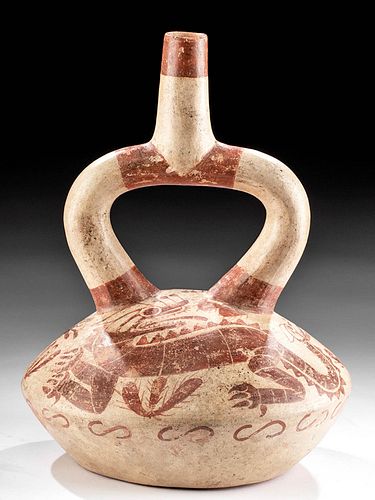Moche Fineline Stirrup Vessel - Strombus Monster
Lot 107h
About Seller
Artemis Fine Arts
686 S Taylor Ave, Ste 106
Louisville, CO 80027
United States
Selling antiquities, ancient and ethnographic art online since 1993, Artemis Gallery specializes in Classical Antiquities (Egyptian, Greek, Roman, Near Eastern), Asian, Pre-Columbian, African / Tribal / Oceanographic art. Our extensive inventory includes pottery, stone, metal, wood, glass and textil...Read more
Estimate:
$2,000 - $3,000
Absentee vs Live bid
Two ways to bid:
- Leave a max absentee bid and the platform will bid on your behalf up to your maximum bid during the live auction.
- Bid live during the auction and your bids will be submitted real-time to the auctioneer.
Bid Increments
| Price | Bid Increment |
|---|---|
| $0 | $25 |
| $300 | $50 |
| $1,000 | $100 |
| $2,000 | $250 |
| $5,000 | $500 |
| $10,000 | $1,000 |
| $20,000 | $2,500 |
| $50,000 | $5,000 |
| $100,000 | $10,000 |
| $200,000 | $20,000 |
About Auction
By Artemis Fine Arts
Feb 13, 2020
Set Reminder
2020-02-13 10:00:00
2020-02-13 10:00:00
America/New_York
Bidsquare
Bidsquare : Exceptional Antiquities, Asian, Ethnographic
https://www.bidsquare.com/auctions/artemis-gallery/exceptional-antiquities-asian-ethnographic-4848
An important one-day auction featuring museum-worthy examples of Egyptian, Greek, Roman, Etruscan, Near Eastern, Far East / Asian, Pre-Columbian, African / Tribal, Oceanic, Native American, Spanish Colonial, Russian, Fossils, Ancient Jewelry, Fine Art, so much more! Artemis Fine Arts info@artemisfinearts.com
An important one-day auction featuring museum-worthy examples of Egyptian, Greek, Roman, Etruscan, Near Eastern, Far East / Asian, Pre-Columbian, African / Tribal, Oceanic, Native American, Spanish Colonial, Russian, Fossils, Ancient Jewelry, Fine Art, so much more! Artemis Fine Arts info@artemisfinearts.com
- Lot Description
Pre-Columbian, Central/North Coast Peru, Moche, Phase V, ca. 600 to 800 CE. A fabulous example of a hand-built and highly burnished pottery vessel with a planar base, a compressed circular body with a protruding central carination, a rounded top, a stirrup-shaped handle with inward-bent arms, and a tapered conical spout on top. The cream-slipped vessel composition is accentuated with solid rings of red-brown slip on the base and top of the handle as well as the spout tip, and a register of repeating lemniscate forms course around the lower body just beneath the carination. Illustrated on the top are two instances of the "Strombus Monster," a terrifying chimeric beast with a striated, feline-form body with serrated back scales, a gaping mouth with sharp teeth and a protruding tongue, and a tail bearing a secondary serpentine head. The monsters are presented with each head gazing to the right, and spiny cacti fill the areas around and beneath the bodies. Size: 6.125" W x 8.1" H (15.6 cm x 20.6 cm)
While there are many fantastical beasts in the bestiary of ancient Moche artistry, none is more intriguing than the Strombus Monster - an amalgam beast that synthesizes characteristics from the sea-dwelling conch shell (Strombus galeatus) and the land snail they were more accustomed to. According to authors Christopher B. Donnan and Donna McClelland, "The Strombus Monster is introduced in Phase IV and is very frequently portrayed. It combines a Strombus shell, a large-eared serpent head, a feline body with claws and pelage markings, and a tail ending in a small-eared serpent head. On its snout are antennae similar to those found on land snails." (Donnan, Christopher B. and Donna McClelland. "Moche Fineline Painting: Its Evolution and Its Artists." UCLA Fowler Museum of Cultural History, Los Angeles, California, 1999, p. 116)
For another example of the Strombus Monster depicted in the fineline technique on a Phase IV stirrup vessel, please see: Donnan, Christopher B. and Donna McClelland. "Moche Fineline Painting: Its Evolution and Its Artists." UCLA Fowler Museum of Cultural History, Los Angeles, California, 1999, p. 87, fig. 4.25.
Provenance: ex-Sloans & Kenyon Auctions, Chevy Chase, Maryland, USA, 1998
All items legal to buy/sell under U.S. Statute covering cultural patrimony Code 2600, CHAPTER 14, and are guaranteed to be as described or your money back.
A Certificate of Authenticity will accompany all winning bids.
We ship worldwide and handle all shipping in-house for your convenience.
#153219Minor nicks and abrasions to base, body, handle, and spout, with fading to original pigmentation and areas of touch-up painting, and light encrustations, otherwise intact and excellent. Light earthen deposits and manganese deposits throughout, and great traces of original pigment in some areas.Condition
- Shipping Info
-
All shipping is handled in-house for your convenience. Your invoice from Artemis Gallery will include shipping calculation instructions. If in doubt, please inquire BEFORE bidding for estimated shipping costs for individual items.
-
- Buyer's Premium



 EUR
EUR CAD
CAD AUD
AUD GBP
GBP MXN
MXN HKD
HKD CNY
CNY MYR
MYR SEK
SEK SGD
SGD CHF
CHF THB
THB















